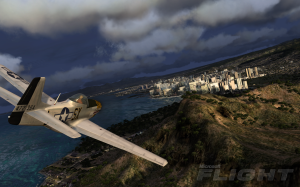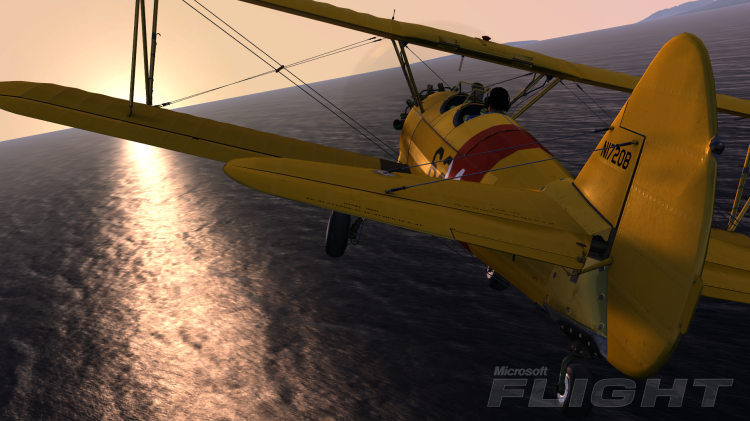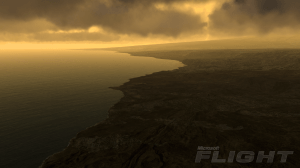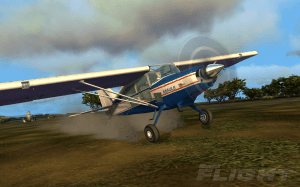WHAT YOU WON’T LIKE
The challenges
These have made their way onto both lists. Personally, I really enjoyed the challenges in Flight, but I can see how some flight simulation veterans could be upset at Microsoft’s addition of arcade style trappings to its game. Basically, you’re either going to love or hate this almost Pilotwings-like approach to conquering the skies. Thankfully if you hate the challenges then you can simple ignore them, and instead immerse yourself in Free Flight mode.
Graphically speaking, Microsoft Flight is a mixed bag. In what is supposed to be an accurate representation of Hawaii, it includes most major landmarks, roads and geographical features in some detail. On the other hand, there is no life on the island, be that pedestrians, traffic, animal life, or even AI controlled planes. The only indications of habitation are your occasional passengers, playing their ukeleles, craving hamburgers at distant airports, and making thoughtful comments such as, “This is cool — we’re flying!”
Entering the multiplayer aspect of the game does result in other planes sharing your airspace, with up to 16 players able to play and communicate on one server. I found it hard to discover a busy game though, mostly just meeting one other pilot at a time.
Less than spectacular crashes
While crashing your plane is definitely an undesirable outcome in Flight, it never proves fatal, and is rarely dramatic. Even heading straight for the upstairs window of a house at 120kts will result in you gently bouncing over the roof, spinning a few times, before ending up in the back garden. On more than one occasion I picked up points for aerobatics, as my plane spun helplessly but delicately down a mountainside. It is a little disappointing that such failures are represented with so little drama, but I suppose screams, breaking glass and broken bones are not the face of aviation that Microsoft wants to present.
Opening up the flying experience to all-comers is definitely top of Microsoft’s agenda for Flight, and making the game free, with a relatively low hardware entry point, certainly supports this aim. After playing the game for a week though, the limitations of what is actually being given away here do become apparent.
With four introductory missions under my belt, nine landing challenges completed, five other challenges undertaken, and thirteen aerocaches discovered, there was nothing much left for me to do. Each airport has a jobs board, which can be accessed on foot, or from the in-game menu, but any mission requiring cargo space is inaccessible with only the two starter planes sitting in the hanger. Earning XP allows you to alter the paintwork on these planes, but any additional planes must be purchased with real money.
Buying the Maule-M-7-260C Orion would give you the cargo space necessary to take on more jobs, but this plane costs $14.99 to unlock. The second plane available to purchase at present is the P-51 Mustang, a legendary warplane from World War 2, known for its speed and maneuverability, but not for its storage space. This will set you back a slightly more reasonable $7.99.
Beside these individual planes, Microsoft is selling access to the rest of the Hawaiian island chain for $19.99. This is dubbed the Hawaiian Adventure Pack, and it opens up new islands, along with associated challenges and one extra plane – the Vans RV-6A. Again, this plane doesn’t have the storage space required to perform cargo missions, so you are back to the problem of forking out $15, just to be able to access all job types, even when buying the Adventure Pack.
 The Hawaiian Adventure Pack is the first of what Microsoft says will be many such add-ons for Microsoft Flight. The company has just announced an Alaska pack, which looks visually stunning, but does raise concerns about how much maintaining full access to Flight will cost in the long run. Buying Alaska, Hawaiian Adventure and the Maule aircraft looks likely to be a $55 proposition, and at that point you are approaching full retail price, with more content set to appear on the horizon.
The Hawaiian Adventure Pack is the first of what Microsoft says will be many such add-ons for Microsoft Flight. The company has just announced an Alaska pack, which looks visually stunning, but does raise concerns about how much maintaining full access to Flight will cost in the long run. Buying Alaska, Hawaiian Adventure and the Maule aircraft looks likely to be a $55 proposition, and at that point you are approaching full retail price, with more content set to appear on the horizon.
CONCLUSION
As an introduction to flight simulation, Microsoft Flight does a sterling job. It is immediately accessible and offers a gentle but genuine challenge. Veteran pilots may find its leaning towards arcade-type challenges a bit of a turn off at first, but flight stick compatibility, a versatile free flight mode, and aerocache hunting all indicate the presence of a deeper game with lasting appeal.
The free content on offer is generous, but on completing all available challenges and missions you may be left feeling that you have been playing an extended demo all along. The decision on whether you board Flight for the long haul will largely be determined by your willingness to embrace Microsoft’s payment model, which is certainly interesting, but could turn out to be a costly long term proposition. Score 72/100
The free version of Microsoft Flight is available to download now.
VentureBeat's mission is to be a digital town square for technical decision-makers to gain knowledge about transformative enterprise technology and transact. Learn More



